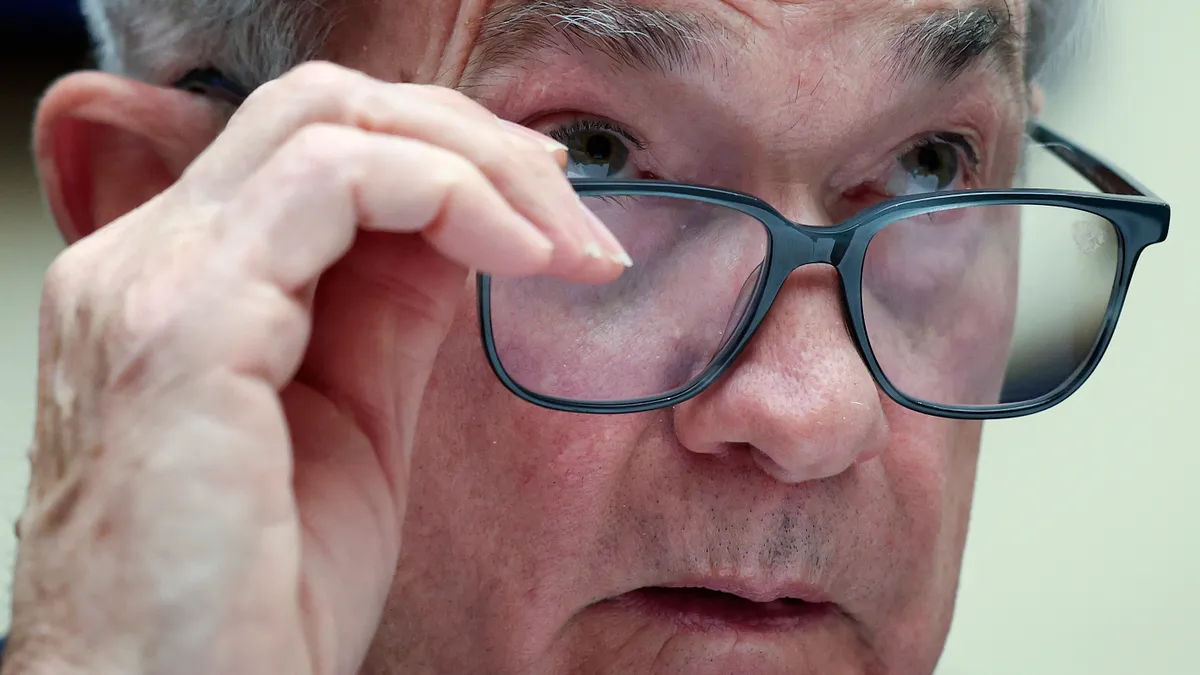Dive Brief:
- Federal Reserve Chair Jerome Powell said Wednesday that a healthy job market and unexpected strength in the economy give policymakers time to mull the pace of future cuts to the benchmark interest rate.
- “The economy is strong and it's stronger than we thought it was going to be in September,” when the Fed began reducing borrowing costs from a two-decade high, Powell said. “The labor market is better, and the downside risks appear to be less in the labor market,” he said during a webcast hosted by The New York Times.
- “So the good news is that we can afford to be a little more cautious as we try to find neutral,” Powell said, referring to a level in the federal funds rate that neither slows nor spurs economic growth.
Dive Insight:
Powell’s comments align with those of other Fed officials in recent days who backed a cautious approach to future reductions in the federal funds rate. Since September the Federal Open Market Committee has trimmed borrowing costs by 0.75 percentage points to a range between 4.5% and 4.75%.
“Recent data have raised the possibility that progress on inflation may be stalling at a level meaningfully above 2%,” Fed Governor Christopher Waller said Monday.
“This risk has raised concerns that the FOMC should consider holding the policy rate constant at our upcoming meeting to collect more information about the future path of inflation and the economy,” Waller said in a speech. He said he is leaning toward voting for a quarter-point cut to the main interest rate at a Dec. 17-18 FOMC meeting.
A measure of inflation excluding volatile food and energy prices and closely tracked by the Fed edged up to a 2.8% annual rate in October from 2.7% in September, persisting above the Fed’s 2% target. The core personal consumption expenditures price index in October increased 0.3%, the Bureau of Economic Analysis said on Nov. 27.
Another gauge of price pressures, the consumer price index, rose at a 2.6% annual rate in October compared with 2.4% the prior month.
Shelter costs increased 0.4% during October, fueling more than half of overall price gains, the Bureau of Labor Statistics said on Nov. 13. The core CPI, excluding volatile food and energy prices, gained 0.3% last month, the same pace as in August and September.
“There are certainly upside risks to price stability,” Atlanta Fed President Raphael Bostic said Monday. “Indeed, our Underlying Inflation Dashboard shows that many measures of inflation remain well above target.”
“Uncertainties persist on various fronts and risks loom both for the health of the labor market and price stability,” he said.
“Still, weighing the totality of the data, I do not view the recent bumpiness as a sign that progress toward price stability has completely stalled,” Bostic said in comments posted on the district bank’s website. “The path toward 2% inflation, while bumpy, looks sustainable.”
Although policymakers have increasingly called for a prudent approach to easing, traders in interest rate futures raised the probability that the Fed will cut the federal funds rate by a quarter point at its next meeting to 76% from 67% on Nov. 27, according to the CME FedWatch Tool.
“Based on the economic data in hand today and forecasts that show that inflation will continue on its downward path to 2% over the medium term, at present I lean toward supporting a cut to the policy rate at our December meeting,” Waller said.
“But that decision will depend on whether data that we will receive before then surprises to the upside and alters my forecast for the path of inflation,” he said.
Price pressures, while volatile, will likely fall over time, Bostic said, citing five reasons. Shelter prices, a persistent spur to inflation, will probably fall over time and the economy will gradually cool, he predicted.
Economic growth and consumer spending have defied predictions of a downturn this year.
Gross domestic product rose at a 2.8% annual rate during the third quarter after increasing 1.4% in Q1 and 3% in Q2, according to the Bureau of Economic Analysis.
The Atlanta Fed on Monday upgraded its estimate for GDP growth during the current quarter to an annual rate of 3.2% from 2.7%.
Despite robust growth, price pressures will likely subside because consumers’ inflation expectations have remained stable and household savings rates have declined, reducing fuel for economic growth, Bostic said. Also, operating costs among businesses continue to stabilize and their pricing power has fallen.
Still, Waller likened combat against inflation to battling a wily opponent in the blood sport of mixed martial arts.
“I feel like an MMA fighter who keeps getting inflation in a choke hold, waiting for it to tap out yet it keeps slipping out of my grasp at the last minute,” Waller said. “But let me assure you that submission is inevitable — inflation isn't getting out of the octagon.”












